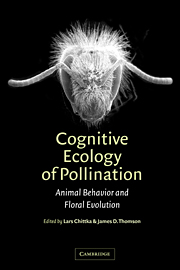Book contents
- Frontmatter
- Contents
- List of contributors
- Preface
- 1 The effect of variation among floral traits on the flower constancy of pollinators
- 2 Behavioral and neural mechanisms of learning and memory as determinants of flower constancy
- 3 Subjective evaluation and choice behavior by nectar-and pollen-collecting bees
- 4 Honeybee vision and floral displays:from detection to close-up recognition
- 5 Floral scent, olfaction, and scent-driven foraging behavior
- 6 Adaptation, constraint, and chance in the evolution of flower color and pollinator color vision
- 7 Foraging and spatial learning in hummingbirds
- 8 Bats as pollinators: foraging energetics and floral adaptations
- 9 Vision and learning in some neglected pollinators: beetles, flies, moths, and butterflies
- 10 Pollinator individuality: when does it matter?
- 11 Effects of predation risk on pollinators and plants
- 12 Pollinator preference, frequency dependence, and floral evolution
- 13 Pollinator-mediated assortative mating: causes and consequences
- 14 Behavioural responses of pollinators to variation in floral display size and their influences on the evolution of floral traits
- 15 The effects of floral design and display on pollinator economics and pollen dispersal
- 16 Pollinator behavior and plant speciation: looking beyond the “ethological isolation” paradigm
- Index
4 - Honeybee vision and floral displays:from detection to close-up recognition
Published online by Cambridge University Press: 13 August 2009
- Frontmatter
- Contents
- List of contributors
- Preface
- 1 The effect of variation among floral traits on the flower constancy of pollinators
- 2 Behavioral and neural mechanisms of learning and memory as determinants of flower constancy
- 3 Subjective evaluation and choice behavior by nectar-and pollen-collecting bees
- 4 Honeybee vision and floral displays:from detection to close-up recognition
- 5 Floral scent, olfaction, and scent-driven foraging behavior
- 6 Adaptation, constraint, and chance in the evolution of flower color and pollinator color vision
- 7 Foraging and spatial learning in hummingbirds
- 8 Bats as pollinators: foraging energetics and floral adaptations
- 9 Vision and learning in some neglected pollinators: beetles, flies, moths, and butterflies
- 10 Pollinator individuality: when does it matter?
- 11 Effects of predation risk on pollinators and plants
- 12 Pollinator preference, frequency dependence, and floral evolution
- 13 Pollinator-mediated assortative mating: causes and consequences
- 14 Behavioural responses of pollinators to variation in floral display size and their influences on the evolution of floral traits
- 15 The effects of floral design and display on pollinator economics and pollen dispersal
- 16 Pollinator behavior and plant speciation: looking beyond the “ethological isolation” paradigm
- Index
Summary
In a social insect such as the honeybee, the survival of the colony depends on the success of its foragers. The bee optimizes its foraging success by returning to flowers of the species at which it has previously found food. This so-called flower constancy (see Chittka et al. 1999 for references) is based on the bee's capacity to learn and memorize specific flower signals (Menzel et al. 1993; Menzel & Müller 1996; Menzel 1999 and this volume) and to discriminate among different species by their different signals.
A bee returning to the feeding site in search of a flower, be it natural or artificial, must first detect the target from a distance. Once the flower has been detected, the bee will approach it up to a distance at which it is able to recognize whether or not the flower is similar to that stored in memory. Among the different sensory cues used, visual cues are of fundamental importance. In the rich market of coexisting and competing flower species, flower colors, shapes, and patterns are the visual cues that allow bees to recognize and discriminate profitable species.
Here we review studies concerned with the bee's use of visual signals for detecting and recognizing food sources. In the first part of the chapter, we examine the role of the bee's color vision in these tasks. In the second part, we look at the role of several spatial parameters contained in achromatic (black-and-white) stimuli.
- Type
- Chapter
- Information
- Cognitive Ecology of PollinationAnimal Behaviour and Floral Evolution, pp. 61 - 82Publisher: Cambridge University PressPrint publication year: 2001
- 52
- Cited by

